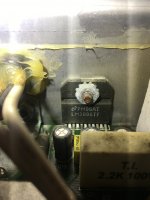Hello,
I’m new here and looking for help understanding the difference in Lm3886 chips as I cannot find a direct replacement for the one that let the smoke out on my studio subwoofer (the elusive Event 20/20 s250). There are 4x chips, one is burnt out. It reads PM96AT LM3886TF, photo attached. I can not find its exact replacement online. Any suggestions on a replacement? Several listing for the JM64RE LM3886TF, will it work the same? Any help is appreciated.
I’m new here and looking for help understanding the difference in Lm3886 chips as I cannot find a direct replacement for the one that let the smoke out on my studio subwoofer (the elusive Event 20/20 s250). There are 4x chips, one is burnt out. It reads PM96AT LM3886TF, photo attached. I can not find its exact replacement online. Any suggestions on a replacement? Several listing for the JM64RE LM3886TF, will it work the same? Any help is appreciated.
Attachments
Ok, I would prefer to only replace the bad one anyways… not broken don’t fix it, right. As for the fault that killed the chip I could not see any visible damage. The units started humming really bad, I turned it off. Then power cycled it and saw sparks and smoke from the vents, humming stopped before I could turn it off. I opened the unit and found the burnt chip. No other signs of failure. I can use a multimeter and compare components, thats it. There is no circuit diagram available. So I’m not sure what I’m looking for. Is the loud hum not a fault of the chip? Thanks for the help, I’m not a electrical engineer but would like to repair this amp my self. Thanks in advance!
What you have is an older National Semiconductor LM3886TF (or LM3886TF/NOPB). If you want an exact match, including matching markings, you'll need to go fishing on eBay. If you would like to replace it with an identical chip produced this year, place an order for an LM3886TF (or LM3886TF/NOPB) through TI or Mouser, Digikey, etc. Beware that the lead time is pretty long these days. Sometimes TI (who bought National Semiconductor some 10+ years ago) releases a small handful on their website. It's all related to the supply chain issues.
There are three current production flavours of the LM3886:
Tom
There are three current production flavours of the LM3886:
- LM3886T/NOPB: Exposed metal back, lead-free finish
- LM3886TF/NOPB: Insulated package, lead-free finish
- LM3886TF: Insulated package, leaded solder used on the pins
Tom
As far as I remember, those Event speakers used the circuits taken directly from the applications manual of the IC's, which means one of your amps is single for the tweeter and the other three work is "parallel" for the woofer.
If the blown IC belongs to the parallel circuit it is possible the series resistor is also "overheated", please check it.
You should not have trouble to find the schematics; but if you cannot find it let me know it and I will look for it.
If the blown IC belongs to the parallel circuit it is possible the series resistor is also "overheated", please check it.
You should not have trouble to find the schematics; but if you cannot find it let me know it and I will look for it.
I will look at the IC manuals to help check the resistors however I do not believe there is a series circuit as this is a 250w subwoofer not the bi-amplified monitors. I will attach some photos of the board.
Attachments
-
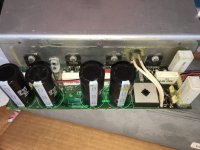 4C25B2D0-29B5-41F2-BADB-7D81669A9E81.jpeg467.2 KB · Views: 110
4C25B2D0-29B5-41F2-BADB-7D81669A9E81.jpeg467.2 KB · Views: 110 -
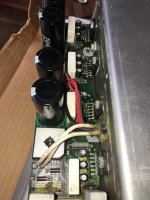 EBF09D49-58DB-4E7B-BB24-EE22F967987C.jpeg473.2 KB · Views: 113
EBF09D49-58DB-4E7B-BB24-EE22F967987C.jpeg473.2 KB · Views: 113 -
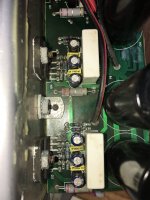 D29EC27D-9F7D-4A64-8426-E40F3E82B7A6.jpeg471 KB · Views: 107
D29EC27D-9F7D-4A64-8426-E40F3E82B7A6.jpeg471 KB · Views: 107 -
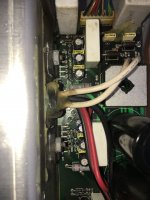 36E5C03C-A42E-4712-B926-5CEAE14FEADC.jpeg407.7 KB · Views: 110
36E5C03C-A42E-4712-B926-5CEAE14FEADC.jpeg407.7 KB · Views: 110 -
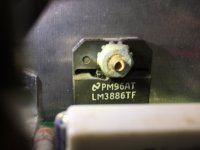 F47BF364-DF26-4744-BC51-B3CDAA14F16D.jpeg320 KB · Views: 103
F47BF364-DF26-4744-BC51-B3CDAA14F16D.jpeg320 KB · Views: 103
Hi K-tech808, sadly I do not have service manual neither schematics for the sub.
Anyway, looking at the pics you posted I am dare to confirm the circuit should be the "typical" application of the manual for the ICs and there is one 0.22 ohm resistor per IC which is the one I suggested to check (it should be wired in series with the output of each amp to limit the flow of current from IC to IC due to the voltage offsets).
Good luck!
Anyway, looking at the pics you posted I am dare to confirm the circuit should be the "typical" application of the manual for the ICs and there is one 0.22 ohm resistor per IC which is the one I suggested to check (it should be wired in series with the output of each amp to limit the flow of current from IC to IC due to the voltage offsets).
Good luck!
Or an output power device (within the chip) shorted. That also puts DC on the speaker output, and the power supply becomes heavily loaded, causing ripple voltage to increase. At the same time the chip's ripple rejection disappears due to the failed output device. So you hear a loud hum from the speakers.Hum, then burn...maybe it got DC on the input.
Depending on how powerful the amplifier is, if the amplifier stays like this for more than a few seconds, the speaker voice coil(s) will burn out, too. That's usually a much bigger disaster than a burned-out amplifier chip.
The LM3886 was limited to a little less than 70 watts RMS for one chip. The subwoofer probably uses four - two groups of two chips in parallel, and the two groups wired in antiphase so the whole thing operates in bridge mode.
One of my long-ago colleagues built an amplifier like this (4 LM3886 in paralleled bridge operation). His amplifier liked to burst into radio frequency oscillation from time to time, smoking one or more of the chips every time this happened. It wasn't a very stable design. He scrapped it after a few too many of these events.
Yours has been stable for a long time, so I would look for aged capacitors on the board, just in case that may have triggered instability, which in turn killed one of the chips.
-Gnobuddy
- Home
- More Vendors...
- Chipamp
- Understanding LM3886 replacements
